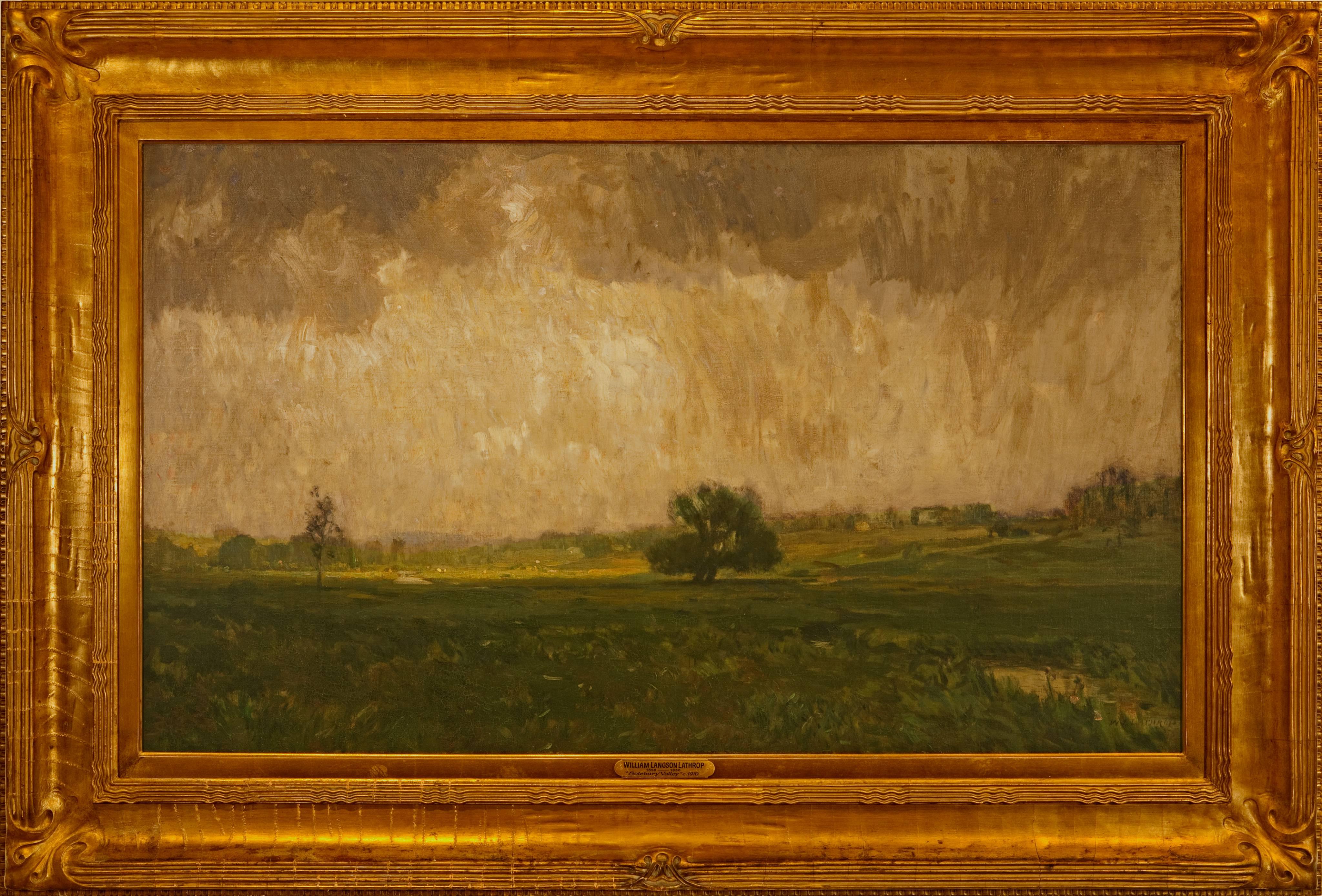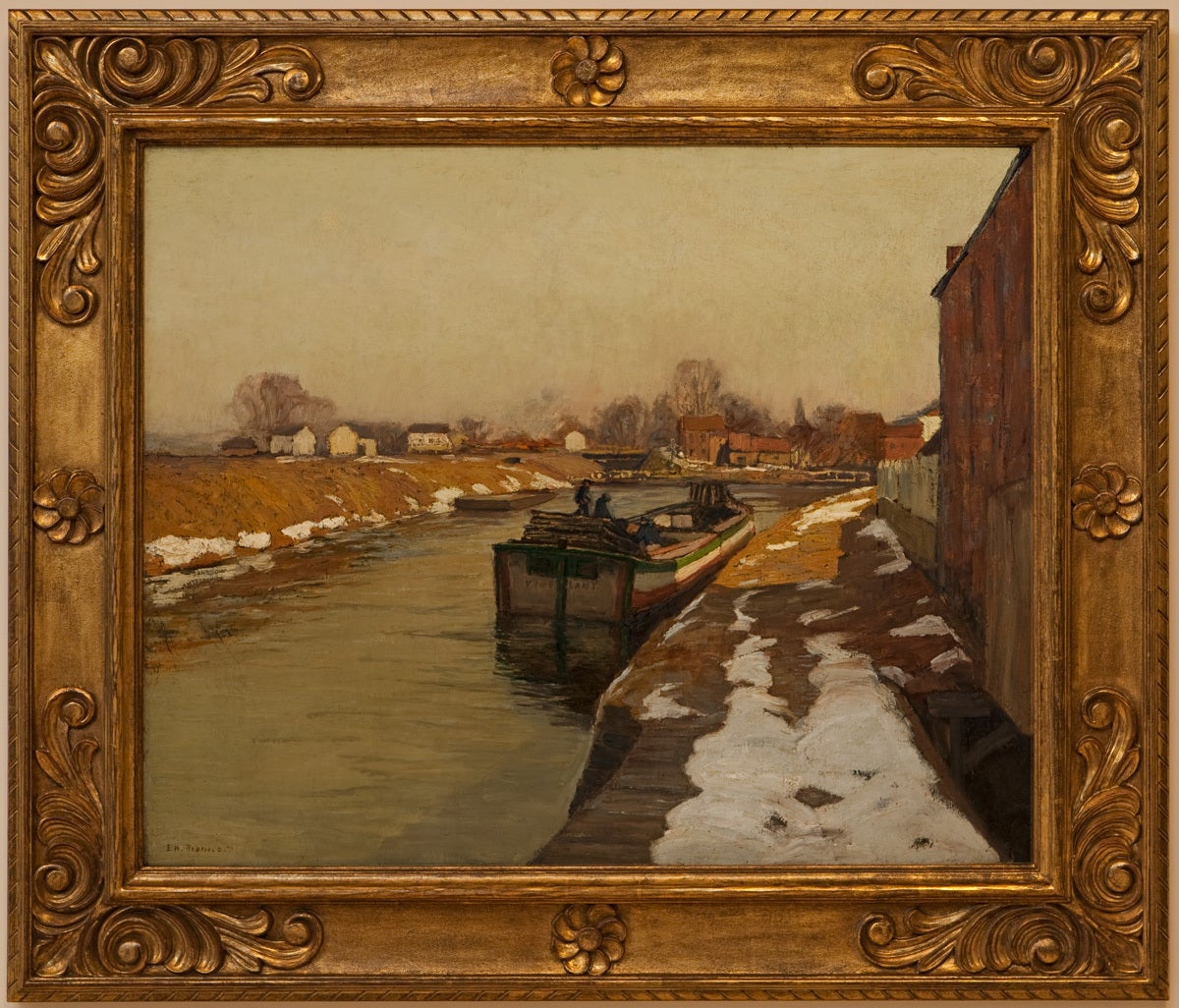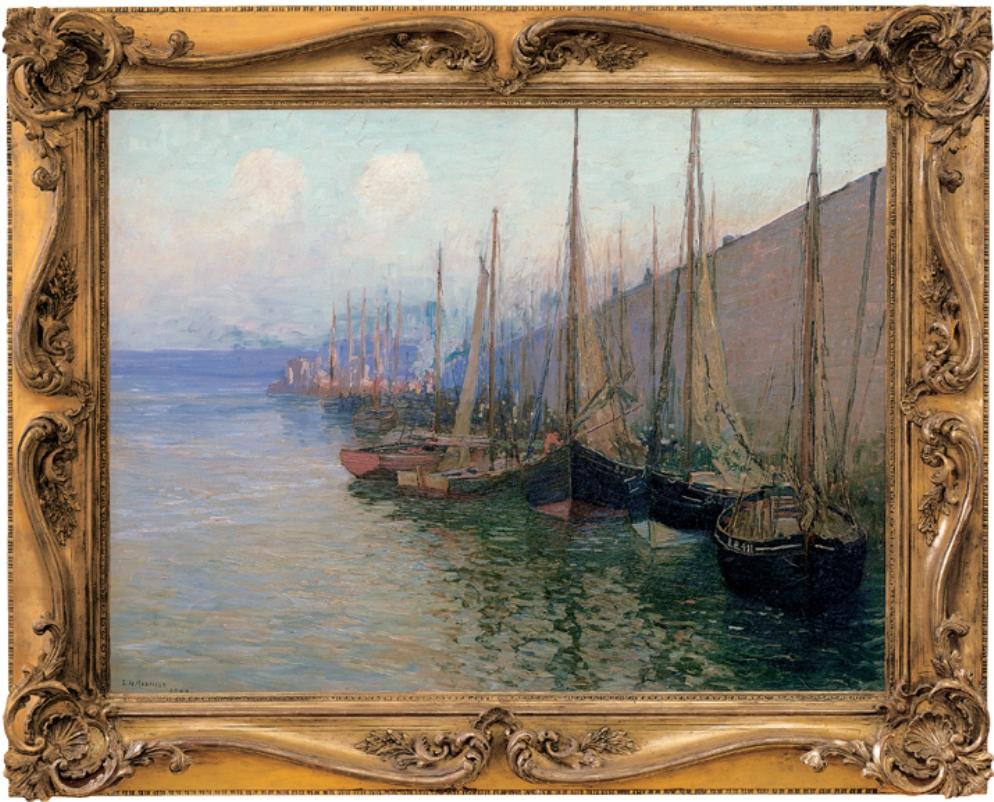Want more images or videos?
Request additional images or videos from the seller
1 of 13
Walter Launt PalmerWinter Scene
About the Item
In this prototypical oil painting, Walter Launt Palmer's title as "the painter of the American winter" can be vividly and brilliantly seen. As an impressionist painter that emerged at the turn of the 20th century, Palmer took great interest in the picturesque American landscape, though he particularly focused on the rendering of this landscape glistening with snow. His pictures evoke an unreplicable natural serenity, and in this oil painting "The Winter Scene," Palmer invites us into a world of stillness. Just after a snowfall, with the trees still frothing with snow on their branches and the ground laid heavy with powder, Palmer captures the sun emerging upon this recently blanketed, peaceful world. The almost pointillist quality of his work is best seen in the water, where vivid colors like purple, yellow, and green dance along the liquid surface. In the shadows, too, we see a rich interplay of deep blues and yellows, perfectly executed through Palmer's technically astute mark-making. This work emerges from a time period in which the great American outdoors was being appreciated and reproduced, with Palmer and contemporaries like William Hart, Homer Dodge Martin, and Edward Gay leading this movement.
- Creator:Walter Launt Palmer (1854-1932, American)
- Dimensions:Height: 30 in (76.2 cm)Width: 30 in (76.2 cm)
- Medium:
- Movement & Style:
- Period:
- Condition:Patch repair to upper right portion of canvas, presumably due to a previous small tear. New lining along the edges of canvas.
- Gallery Location:New York, NY
- Reference Number:1stDibs: LU163729469202
About the Seller
5.0
Vetted Seller
These experienced sellers undergo a comprehensive evaluation by our team of in-house experts.
Established in 1948
1stDibs seller since 2021
7 sales on 1stDibs
- ShippingRetrieving quote...Ships From: New York, NY
- Return PolicyA return for this item may be initiated within 14 days of delivery.
More From This SellerView All
- HaystacksBy Abraham WalkowitzLocated in New York, NYHaystacks by Abraham Walkowitz (1878-1965) Oil on canvas 14 x 20 inches unframed (35.56 x 50.8 cm) 19 ½ x 25 ½ inches framed (49.53 x 64.77 cm) Signed on lower right Description: Ab...Category
20th Century American Impressionist Landscape Paintings
MaterialsOil
- Coastal SceneBy Sigurd Solver SchouLocated in New York, NYCoastal Scene by Sigurd Solver Schou (1875-1944) Oil on panel 10 x 13 inches unframed ( 25.4 x 33.02 cm) 14 ½ x 17 ⅛ inches framed (36.83 x 43.4975 cm)...Category
20th Century Impressionist Landscape Paintings
MaterialsOil
- The Young ShepherdessBy Charles Amable LenoirLocated in New York, NYThe Young Shepherdess by Charles Amable Lenoir (1860-1926) Oil on canvas 48 x 32 inches unframed (121.92 x 81.28 cm.) 58 ½ x 42 ¾ inches framed (148.59 x 10...Category
Late 19th Century Academic Portrait Paintings
MaterialsOil
- The CrossingBy Charles Théodore FrèreLocated in New York, NYThe Crossing, 1855, by Theodore Frere (1814-1888) Oil on wood panel 9 x 14 inches unframed (22.86 x 35.56 cm) 17 ¾ x 22 ½ inches framed (45.085 x 57.15 cm...Category
19th Century Academic Landscape Paintings
MaterialsOil
- Wild HorsesBy Mark TobeyLocated in New York, NYWild Horses by Mark Tobey (1890-1976) Oil on panel 10 ¾ x 16 ½ inches unframed (27.305 x 41.91 cm) 14 x 19 ½ inches framed (35.56 x 49.53 cm) Signed on bot...Category
Late 20th Century Abstract Expressionist Landscape Paintings
MaterialsOil
- IpswichBy Theodore WendelLocated in New York, NYIpswich, 1901, by Theodore Wendel (1859-1932) Oil on canvas 9 x 14 inches unframed (22.86 x 35.56 cm) 14 ½ x 19 ½ inches framed (36.67125 x 49.68875 cm) Signed and dated on reverse ...Category
Early 20th Century Landscape Paintings
MaterialsOil
You May Also Like
- "Alley Fiends"By John R. GrabachLocated in Lambertville, NJJim’s of Lambertville is proud to offer this artwork by: John R. Grabach (1886 - 1981) John Grabach was a highly regarded New Jersey artist, teacher, and author of the classic text...Category
1930s American Impressionist Landscape Paintings
MaterialsCanvas, Oil
- "Forest Strongholds"By John F. CarlsonLocated in Lambertville, NJSigned lower right. Complemented by a hand carved and gilt frame. Exhibited at the National Academy of Design, 1928Category
20th Century American Impressionist Landscape Paintings
MaterialsCanvas, Oil
- "Solebury Valley"By William Langson LathropLocated in Lambertville, NJSigned lower right. Complemented by a period frame. William L. Lathrop (1859-1938) Deemed “Father of the New Hope Art Colony”, William Langson Lathrop was born in Warren, Illinois. He was largely self-taught, having only studied briefly with William Merritt Chase in 1887, at the Art Students League. Lathrop first moved east in the early 1880s, and took a job at the Photoengraving Company in New York City. While there, he befriended a fellow employee, Henry B. Snell. The two men became lifelong friends and ultimately, both would be considered central figures among the New Hope Art Colony. Lathrop's early years as an artist were ones of continuing struggle. His efforts to break through in the New York art scene seemed futile, so he scraped enough money together to travel to Europe with Henry Snell in1888. There he met and married an English girl, Annie Burt. Upon returning to New York, he tried his hand at etching, making tools from old saw blades...Category
1910s American Impressionist Landscape Paintings
MaterialsCanvas, Oil
- Winter MoonlightBy George William SotterLocated in Lambertville, NJsigned lower rightCategory
1910s American Impressionist Landscape Paintings
MaterialsCanvas, Oil
- "The Canal"By Edward Willis RedfieldLocated in Lambertville, NJJim’s of Lambertville is proud to offer this artwork. Signed lower left. Complemented by a hand carved and gilt frame. Illustrated in "Edward Redfield: Just Values and Fine Seeing" by Constance Kimmerle and the Pennsylvania Academy of the Fine Arts's Exhibition of Paintings by Edward Redfield (April 17 to May 16, 1909) brochure Edward Willis Redfield (1869 - 1965) Edward W. Redfield was born in Bridgeville, Delaware, moving to Philadelphia as a young child. Determined to be an artist from an early age, he studied at the Spring Garden Institute and the Franklin Institute before entering the Pennsylvania Academy from 1887 to 1889, where he studied under Thomas Anshutz, James Kelly, and Thomas Hovenden. Along with his friend and fellow artist, Robert Henri, he traveled abroad in 1889 and studied at the Academie Julian in Paris under William Bouguereau and Tony Robert-Fleury. While in France, Redfield met Elise Deligant, the daughter of an innkeeper, and married in London in 1893. Upon his return to the United States, Redfield and his wife settled in Glenside, Pennsylvania. He remained there until 1898, at which time he moved his family to Center Bridge, a town several miles north of New Hope along the Delaware River. Redfield painted prolifically in the 1890s but it was not until the beginning of the twentieth century that he would develop the bold impressionist style that defined his career. As Redfield’s international reputation spread, many young artists gravitated to New Hope as he was a great inspiration and an iconic role model. Edward Redfield remained in Center Bridge throughout his long life, fathering his six children there. Around 1905 and 1906, Redfield’s style was coming into its own, employing thick vigorous brush strokes tightly woven and layered with a multitude of colors. These large plein-air canvases define the essence of Pennsylvania Impressionism. By 1907, Redfield had perfected his craft and, from this point forward, was creating some of his finest work. Redfield would once again return to France where he painted a small but important body of work between 1907 and 1908. While there, he received an Honorable Mention from the Paris Salon for one of these canvases. In 1910 he was awarded a Gold Medal at the prestigious Buenos Aires Exposition and at the Panama-Pacific Exposition of 1915 in San Francisco, an entire gallery was dedicated for twenty-one of his paintings. Since Redfield painted for Exhibition with the intent to win medals, his best effort often went into his larger paintings. Although he also painted many fine smaller pictures, virtually all of his works were of major award-winning canvas sizes of 38x50 or 50x56 inches. If one were to assign a period of Redfield’s work that was representative of his “best period”, it would have to be from 1907 to 1925. Although he was capable of creating masterpieces though the late 1940s, his style fully matured by 1907 and most work from then through the early twenties was of consistently high quality. In the later 1920s and through the 1930s and 1940s, he was like most other great artists, creating some paintings that were superb examples and others that were of more ordinary quality. Redfield earned an international reputation at a young age, known for accurately recording nature with his canvases and painting virtually all of his work outdoors; Redfield was one of a rare breed. He was regarded as the pioneer of impressionist winter landscape painting in America, having few if any equals. Redfield spent summers in Maine, first at Boothbay Harbor and beginning in the 1920s, on Monhegan Island. There he painted colorful marine and coastal scenes as well as the island’s landscape and fishing shacks. He remained active painting and making Windsor style furniture...Category
Early 1900s American Impressionist Landscape Paintings
MaterialsCanvas, Oil
- "In Port"By Edward Willis RedfieldLocated in Lambertville, NJJim’s of Lambertville is proud to offer this artwork by: Edward Willis Redfield (1869 - 1965) Edward W. Redfield was born in Bridgeville, Delaware, moving to Philadelphia as a young child. Determined to be an artist from an early age, he studied at the Spring Garden Institute and the Franklin Institute before entering the Pennsylvania Academy from 1887 to 1889, where he studied under Thomas Anshutz, James Kelly, and Thomas Hovenden. Along with his friend and fellow artist, Robert Henri, he traveled abroad in 1889 and studied at the Academie Julian in Paris under William Bouguereau and Tony Robert-Fleury. While in France, Redfield met Elise Deligant, the daughter of an innkeeper, and married in London in 1893. Upon his return to the United States, Redfield and his wife settled in Glenside, Pennsylvania. He remained there until 1898, at which time he moved his family to Center Bridge, a town several miles north of New Hope along the Delaware River. Redfield painted prolifically in the 1890s but it was not until the beginning of the twentieth century that he would develop the bold impressionist style that defined his career. As Redfield’s international reputation spread, many young artists gravitated to New Hope as he was a great inspiration and an iconic role model. Edward Redfield remained in Center Bridge throughout his long life, fathering his six children there. Around 1905 and 1906, Redfield’s style was coming into its own, employing thick vigorous brush strokes tightly woven and layered with a multitude of colors. These large plein-air canvases define the essence of Pennsylvania Impressionism. By 1907, Redfield had perfected his craft and, from this point forward, was creating some of his finest work. Redfield would once again return to France where he painted a small but important body of work between 1907 and 1908. While there, he received an Honorable Mention from the Paris Salon for one of these canvases. In 1910 he was awarded a Gold Medal at the prestigious Buenos Aires Exposition and at the Panama-Pacific Exposition of 1915 in San Francisco, an entire gallery was dedicated for twenty-one of his paintings. Since Redfield painted for Exhibition with the intent to win medals, his best effort often went into his larger paintings. Although he also painted many fine smaller pictures, virtually all of his works were of major award-winning canvas sizes of 38x50 or 50x56 inches. If one were to assign a period of Redfield’s work that was representative of his “best period”, it would have to be from 1907 to 1925. Although he was capable of creating masterpieces though the late 1940s, his style fully matured by 1907 and most work from then through the early twenties was of consistently high quality. In the later 1920s and through the 1930s and 1940s, he was like most other great artists, creating some paintings that were superb examples and others that were of more ordinary quality. Redfield earned an international reputation at a young age, known for accurately recording nature with his canvases and painting virtually all of his work outdoors; Redfield was one of a rare breed. He was regarded as the pioneer of impressionist winter landscape painting in America, having few if any equals. Redfield spent summers in Maine, first at Boothbay Harbor and beginning in the 1920s, on Monhegan Island. There he painted colorful marine and coastal scenes as well as the island’s landscape and fishing shacks. He remained active painting and making Windsor style furniture...Category
Early 1900s American Impressionist Landscape Paintings
MaterialsCanvas, Oil
Recently Viewed
View AllMore Ways To Browse
American Brilliant Period
William Hart
William Gay
Antique Gay
Powder Snow
Antique Gay Art
After The Snowfall
Edward Gay
Old Luxembourg
Rose Bush
Under The Moonlight
Vintage Oil On Canvas Paintings Sailboats
Washington Crossing
World Fair Tapestry
19th Century Oil Painting Cows
5th Avenue New York
American Clipper Ship
Artist Ben Fenske





